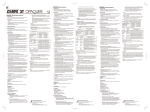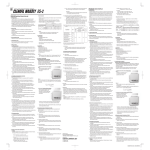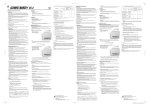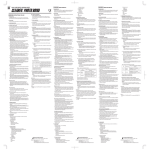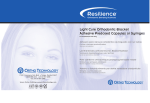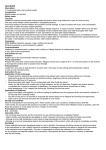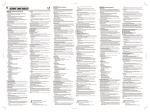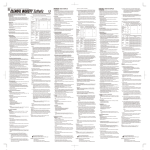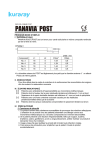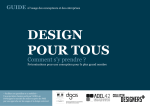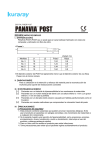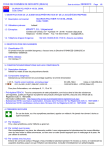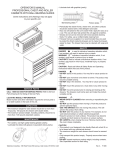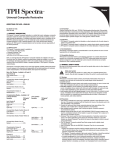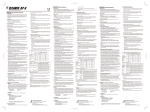Download instructions for use english mode d`emploi français modo de empleo
Transcript
002 C2841-EUI DENTAL LIGHT-CURED RESTORATIVE COMPOSITE ENGLISH INSTRUCTIONS FOR USE I. INTRODUCTION CLEARFIL PHOTO BRIGHT is a light-curing composite resin for anterior use. It has precise colour matching, excellent surface gloss and mechanical properties, making it ideal for esthetic applications. Its right viscosity means it adapts easily to the surface of the tooth and other layers of composite. The product is available in several translucent enamel colours and opaque dentin colours. II. INDICATIONS CLEARFIL PHOTO BRIGHT is recommended for the following restorative applications • Class III, IV and V restorations. • Direct veneers III. CONTRAINDICATION Patients with a history of hypersensitivity to methacrylate monomers IV. INCOMPATIBILITY Do not use eugenol containing materials for pulp protection or temporary sealing, since the eugenol can retard the bonding system curing process. V. PRECAUTIONS 1. Safety precautions 1. Avoid use of the product for patients with a history of hypersensitivity to methacrylate monomers. 2. If any hypersensitivity such as dermatitis occurs, discontinue the use of the product and consult a physician. 3. Wear gloves or take other appropriate protective measures to prevent the occurrence of hypersensitivity that may result from contact with methacrylate monomer. 4. Use caution to prevent the product from coming in contact with the skin or getting into the eye. Before using the product, cover the patient's eyes with a towel to protect the patient's eyes from splashing material. 5. If the product comes in contact with human body tissues, take the following actions: < If the product gets in the eye> Immediately rinse the eye with copious amounts of water and consult a physician. < If the product comes in contact with the skin or the oral mucosa> Immediately wipe it off with a cotton pledget moistened with alcohol or gauze and rinse with copious amounts of water. 6. Use caution to prevent the patient from accidentally swallowing the product. 7. Avoid looking directly at the dental curing light when curing the product. 8. To prevent cross infection, avoid sharing the same paste among different patients. 9. Dispense the paste on a mixing paper before use. 10. Do not try to apply the paste directly from the syringe onto the patient's tooth. 2. Handling and manipulation precautions 1. The use of the product is restricted to licensed dentist. 2. The product should be returned to room temperature before dispensing, if it has been taken out of a refrigerator. Failure to do this might cause breakage of the syringe. 3. The paste should be used as soon as practicable after being dispensed from the syringe. If the paste is to be left for a while before use, it should be covered with a light blocking plate. 4. Do not use the product in conjunction with the other composite resin. Mixing materials may cause a change in physical properties, possibly a decrease, from the properties expected. 5. If the adherent surface extends to uncut enamel, apply a phosphoric acid etching agent (e.g. K-ETCHANT GEL) and leave it in place for 10 seconds before washing and drying. 6. When light curing the product, note the light curing depth in this Instructions for Use. 7. The emitting tip of the dental curing light should be held as near and vertical to the resin surface as possible. If a large resin surface is to be light cured, it is advisable to divide the area into several sections and light-cure each section separately. 8. Low light intensity causes poor adhesion. Check the lamp for service life and the dental curing light guide tip for contamination. It is advisable to check the dental curing light intensity using an appropriate light-evaluating device at appropriate intervals. 3. Storage precautions 1. Do not use the product after the expiration date. Note the expiration date on the outside of package. 2. The product must be stored at 2 - 25°C / 36 - 77°F when not in use. 3. Keep away from extreme heat and direct sunlight. 4. After the paste has been dispensed, the syringe should be capped securely as soon as possible to prevent the paste inside the syringe from being hardened by ambient light, and to keep foreign matter from entering the syringe. 5. The product must be stored in proper places where only dental practitioners can access it. FRANÇAIS MODE D'EMPLOI VII. CLINICAL PROCEDURES 1. Shade taking Choose a suitable shade of the product using the shade guide. Two or more shades can be used for multi-layering to achieve better colour match for the treating tooth. 2. Controlling the moisture For the best results, prevent the treating surface from contamination by saliva or blood. A rubber dam is recommended to keep the working area clean and dry. II. INDICATIONS CLEARFIL PHOTO BRIGHT est indiqué pour les applications restauratrices suivantes: • Restaurations de classe III, IV et V. • Facettes composites. 3. Preparing the cavity Remove the infected dentin and prepare the cavity in the conventional manner. III. CONTRE-INDICATION Patients avec des antecédents présentant une hypersensibilité aux monomères méthacrylates 4. Protecting the pulp An exposed or nearly exposed pulp must be covered with a calcium-hydroxide material. A liner or other under-layer is not required. Do not use eugenol-containing materials for the pulp protection. IV. INCOMPATIBILITE Ne pas utiliser de produits contenant de l'eugénol pour protéger la pulpe ou comme colmatage provisoire, étant donné que l'eugénol risque de retarder le processus de polymérisation du système d'adhésion. 5. Treating tooth surface and bonding See the instructions for the bonding system (such as CLEARFIL TRI-S BOND, CLEARFIL SE BOND or CLEARFIL PHOTO BOND) V. PRECAUTIONS D’EMPLOI 1. Consignes de sécurité 1. Eviter d’utiliser ce produit avec des patients présentant une hypersensibilité aux monomères méthacrylates. 2. Si n’importe quelle hypersensibilité se produit, telle qu’une dermatite, arrêter l’utilisation du produit et consulter un médecin. 3. Porter des gants de caoutchouc ou prendre d’autres mesures de protection appropriées pour éviter la présence d’une hypersensibilité risquant de survenir d’un contact avec des monomères méthacrylates. 4. Prendre les précautions adéquates pour éviter tout contact du produit avec la peau ou les yeux. Avant d'utiliser le produit, protégez les yeux du patient d'une projection du produit en les recouvrant d'une serviette. 5. Si le produit entre en contact avec les tissus du corps humain, prendre les mesures suivantes: <Si le produit pénètre dans les yeux> Rincer immédiatement les yeux avec beaucoup d’eau et consulter un médecin. <Si le produit entre en contact avec la peau ou la muqueuse buccale> Essuyer immédiatement le produit à l’aide d’un tampon de coton ou d’un gaze imbibé d’alcool et rincer abondamment à l’eau. 6. Veillez à ce que le patient n'avale pas par inadvertance le produit. 7. Eviter de regarder en face le spot lumineux de polymérisation lors de la polymérisation du produit. 8. Pour éviter une infection croisée, éviter de partager la même pâte parmi différents patients. 9. Déposer la pâte sur un papier pour mélange avant l’utilisation. 10. Ne pas essayer d’appliquer directement la pâte à partir d’une seringue sur la dent du patient. 6. Place and Applying and curing CLEARFIL PHOTO BRIGHT Apply the paste to the cavity and cure it with a dental curing unit according to the time on the table 1. Table 1: Relationship between curing time and curing depth for each dental curing unit. Curing time Curing depth (mm) Type (Sec.) Conventional 20 halogen* Fast halogen* 10 Plasma arc* 5 LED* 1.5 20 *Dental curing unit Light Type source Conventional Halogen halogen lamp Halogen Fast halogen lamp Plasma arc Xenon lamp LED Blue LED1) Range of wavelength and light intensity Light intensity of 300-550 mW/cm with wavelength range of 400-515 nm Light intensity2) over 550mW/cm2 wavelength range from 400-515 nm 2) 2 Light intensity3) over 2000mW/cm2 in wavelength range of 400-515 nm, and light intensity over 450 mW/cm2 in wavelength range of 400-430 nm Light intensity over 300mW/cm in wavelength range from 400-515 nm 4) 2 1) Emissions spectrum peak: 450-480mm 2) Evaluated according to ISO 10650-1. 3) Wavelength distribution and light intensity values measured with a spectroradiometer, calibrated using an IEC or NIST (National Institute of Standards and Technology) standard lamp 4) Evaluated according to ISO 10650-2. [NOTE] If you have selected two or more shades, a layer of the first colour must be applied and cured before a layer of the next colour is applied. 7. Finishing Finish the restoration with a fine diamond point. Polish with a silicone-rubber tip or polishing discs in the conventional manner. [WARRANTY] Kuraray Noritake Dental Inc. will replace any product that is proved to be defective. Kuraray Noritake Dental Inc. does not accept liability for any loss or damage, direct, consequential or special, arising out of the application or use of or the inability to use these products. Before using, the user shall determine the suitability of the products for the intended use and the user assumes all risk and liability whatsoever in connection therewith. [NOTE] CLEARFIL MAJESTY, CLEARFIL TRI-S BOND, CLEARFIL SE BOND, CLEARFIL PHOTO BOND, CLEARFIL ST and CLEARFIL are trademarks of KURARAY CO., LTD. [NOTA] La teneur totale en charge inorganique est d’environ 32 vol%. La taille des particules de la charge de remplissage va de 0.04 μm à 17 μm. VII. PROCÉDURES CLINIQUES 1. Prise de teinte Sélectionner une teinte adaptée à l’aide du nuancier. Il est possible d’utiliser deux teintes, ou plus, dans le cadre d’une stratification afin que la couleur de la dent traitée corresponde au mieux. 2. Contrôle de l’humidité Pour obtenir les meilleurs résultats possibles, faire en sorte de ne pas contaminer la surface à traiter par de la salive ou du sang. Il est recommandé d’utiliser une digue pour que la zone de travail reste propre et sèche. 3. Préparation de la cavité Retirer la dentine infectée et préparer la cavité selon la méthode habituelle. 4. Protection pulpaire La partie de la pulpe qui est exposée, ou presque exposée, doit être recouverte d’une préparation à base d’hydroxyde de calcium. Il n’est pas nécessaire d’utiliser un fond de cavité ou toute autre sous-couche. Ne pas utiliser de matériaux contenant de l’eugénol pour protéger la pulpe. 5. Traitement de la surface de la dent et collage Voir les instructions relatives au système de collage (comme, par exemple, CLEARFIL TRI-S BOND, CLEARFIL SE BOND ou CLEARFIL PHOTO BOND). 6. Application et polymérisation de CLEARFIL PHOTO BRIGHT Déposer la pâte dans la cavité et procéder à la polymérisation à l’aide d’une lampe à polymériser dentaire selon la durée indiquée dans le tableau 1. Table1: Relation entre la durée de polymérisation et la profondeur de polymérisation pour chaque unité de polymérisation dentaire. Temps de Profondeur de Type polymérisation polymérisation (mm) (sec) Halogène 20 conventionnel* Halogène puissant* 10 1.5 Arc de plasma* LED* 5 20 *Unité de polymérisation dentaire Source Type Gamme d’ondes et intensité de lumière lumineuse Lampe Intensité lumineuse2) de 300 - 550 mW/cm2 Halogène conventionnel halogène en gamme d’ondes de 400 - 515 nm Lampe Halogène Intensité lumineuse2) de plus de 550 mW/cm2 halogène en gamme d’ondes de 400 - 515 nm puissant Arc de plasma Lampe Xenon Intensité lumineuse3) de plus de 2000 mW/cm2 en gamme d’ondes de plus de 400 - 515 nm, et intensité lumineuse de plus de 450 mW/cm2 en gamme d’ondes de 400 - 430 nm LED LED bleue1) Intensité lumineuse4) de plus de 300 mW/cm2 en gamme d’ondes de 400 - 515 nm 1) Maximum du spectre d’émission : 450 - 480 nm 2) Évalué conformément à la norme ISO 10650-1. 3) Gamme d’ondes et valeur de l’intensité lumineuse mesurées avec un spectroradiomètre qualibré en utilisant une lampe standard IEC ou la lampe standard du NIST (National Institute of Standards and Technology) 4) Évalué conformément à la norme ISO 10650-2. [NOTA] Si vous avez sélectionné deux teintes ou plus, vous devez appliquer et polymériser une la couche de la première teinte avant d’apposer la teinte suivante. 7. Finition Achever la restauration à l’aide d’une fine pointe diamant. Polir de manière classique avec une pointe silicone ou des polissoirs. [GARANTIE] Kuraray Noritake Dental Inc. remplacera tous les produits dont la défectuosité est établie. Kuraray Noritake Dental Inc. ne répond pas de pertes ni de dommages directs ou indirects ou inhabituels découlant de l'emploi ou d'un emploi non approprié de ces produits. L'utilisateur est tenu de vérifier la convenance des produits avant leur emploi aux fins d'utilisation prévues et assumera tous les risques et obligations qui s'y rattachent. [NOTA] CLEARFIL MAJESTY, CLEARFIL TRI-S BOND, CLEARFIL SE BOND, CLEARFIL PHOTO BOND, CLEARFIL ST et CLEARFIL sont des marques de KURARAY CO., LTD. CLEARFIL PHOTO BRIGHT CLEARFIL PHOTO BRIGHT Shade guide Kuraray Europe GmbH Philipp-Reis-Str. 4, 65795 Hattersheim am Main, Germany Phone:+49 (0)69 305 35 840 Fax:+49 (0)69 305 35 640 II. INDICACIONES CLEARFIL PHOTO BRIGHT se recomienda para las aplicaciónes restaurativas siguientes: • Restauraciones de clase III, IV y V. • Carillas directas VII. PROCEDIMIENTOS CLÍNICOS 1. Escoger la tonalidad Elija una tonalidad del producto adecuada utilizando la guía de tonalidades. Se pueden utilizar dos o más tonalidades para las multicapas para conseguir una mejor igualación del color sobre el diente tratado. 2. Controlar la humedad Para obtener mejores resultados, evite que la superficie tratada se contamine por saliva o sangre. Se recomienda el uso de un dique de goma para mantener el área de trabajo limpia y seca. III. CONTRAINDICACIÓN Pacientes con un historial de hipersensibilidad a los monómeros de metacrilato 3. Preparar la cavidad Elimine la dentina infectada y prepare la cavidad del modo convencional. IV. INCOMPATIBILIDAD No utilice materiales que contengan eugenol para la protección de la pulpa o para el cementado temporal, porque el eugenol puede alterar el proceso de fraguado del sistema de adhesión. 4. Proteger la pulpa Una pulpa desprotegida o casi desprotegida debe ser cubierta con material hecho a base de hidróxido de calcio. No es necesario un liner ni una capa de sustrato. No utilice materiales que contengan eugenol para la protección de la pulpa. V. PRECAUCIONES 1. Normas de seguridad 1. Evite usar el producto con pacientes que cuentan con un historial de hipersensibilidad a los monómeros de metacrilato. 2. Si se produce algún tipo de hipersensibilidad como, por ejemplo, una dermatitis, interrumpa el uso del producto y consulte a un médico. 3. Póngase guantes o tome otras medidas de protección apropiadas para impedir que se produzca hipersensibilidad debida al contacto con monómeros de metacrilato. 4. Ponga cuidado en evitar que el producto entre en contacto con la piel o entre en los ojos. Antes de usar el producto, cubra los ojos del paciente con una toalla para evitar que entren en ellos salpicaduras del material. 5. Si el producto entra en contacto con los tejidos del cuerpo humano tome las medidas siguientes: <Si el producto entra en los ojos> Aclare inmediatamente los ojos con una cantidad abundante de agua y consulte a un médico. <Si el producto entra en contacto con la piel o la encía> Límpielo inmediatamente pasando una gasa o un trozo de algodón humedecido en alcohol, y luego aclare la zona afectada con una cantidad abundante de agua. 6. Tenga cuidado en impedir que el paciente ingiera el producto por acdente. 7. Evite mirar directamente la luz de fotopolimerización dental al polimerizar el producto. 8. Para evitar la transmisión de infecciones, evite compartir la misma pasta con diferentes pacientes. 9. Ponga la pasta en un papel de mezcla antes de usarla. 10. No intente aplicar la pasta directamente de la jeringa a los dientes del paciente. 2. Precauciones de manejo y manipulación 1. El uso de este producto está limitado a dentistas que dispongan de la debida licencia. 2. El producto, si ha sido sacado de un refrigerador, deberá ponerse a la temperatura ambiente antes de aplicarlo. Si no sigue esta recomendación, puede que la jeringa se rompa. 3. La pasta deberá ser usada tan pronto como sea posible después de extraela de la jeringa. Si la pasta se deja expuesta antes de usarla se recomienda cubrirla con una placa opaca a la luz. 4. No use el producto junto con otros composites antes de polimerizar. La mezcla de materiales puede causar un cambio en las propiedades físicas del producto, incluyendo una posible disminución de las propiedades esperadas. 5. Si la superficie adherente se extiende hasta el esmalte sin preparar, aplique agente de grabado fosfórico (ej., K-ETCHANT GEL) y déjelo en su lugar durante 10 segundos antes de lavarlo y secarlo. 6. Cuando fotopolimerice el producto, tenga en cuenta la profundidad de fotopolimerización indicada en estas instrucciones de uso. 7. El extremo visible de la guía de la luz de la lámpara deberá mantenerse tan cerca y vertical a la superficie del composite como sea posible. Si hay que fotopolimerizar una superficie de composite grande, es aconsejable dividir la superficie en varias secciones y fotopolimerizar cada una de las mismas por separado. 8. La luz de baja intensidad causa una mala adhesión. Compruebe la lámpara para conocer su duración de servicio y la guía luminosa de la luz de la lámpara por si está sucia. Se recomienda comprobar la intensidad de la luz de la lámpara usando el dispositivo de evaluación de luz apropiado a los intervalos apropiados. 3. Precauciones para guardar el producto 1. No use el producto después de la fecha de caducidad. Observe la fecha de caducidad en la parte externa del envase. 2. El producto deberá guardarse a temperaturas de 2 - 25°C / 36 77°F cuando no se utilice. 3. Mantener el producto alejado del calor extremo y de la luz solar directa. 4. Después de dosificar la pasta, la jeringa deberá taparse tan pronto como sea posible para impedir que la pasta del interior de la jeringa se endurezca debido a la luz ambiental, y para impedir que entren materias extrañas al interior de la jeringa. 5. El producto deberá guardarse en los lugares apropiados, donde sólo puedan manipularlo los dentistas. 5. Tratar la superficie del diente y unir Vea las instrucciones para el sistema de adherencia (tal como CLEARFIL TRI-S BOND, CLEARFIL SE BOND o CLEARFIL PHOTO BOND). 6. Poner, aplicar y curar con CLEARFIL PHOTO BRIGHT Aplique la pasta a la cavidad y deje curar con una unidad de curado dental de acuerdo con el tiempo mostrado en la tabla 1. Tabla 1: Relación entre el tiempo de polimerización y la profundidad de polimerización para cada unidad de polimerización dental. Tiempo de Profundidad de Tipo polimerización polimerización (mm) (seg.) Halógena 20 convencional* Halógena rápida* 10 Arco de plasma* 5 LED* 1.5 20 *Unidad de polimerización dental Fuente Gama de longitudes de onda Tipo de luz e intensidad luminosa 2) de 300 Lámpara Intensidad luminosa Halógena 2 550 mW/cm en la gama de longitudes convencional halógena de onda de 400 - 515 nm 2) de más de Lámpara Intensidad luminosa Halógena 2 halógena 550 mW/cm en la gama de longitudes de rápida onda de 400 - 515 nm Arco de plasma Intensidad luminosa3) de más de 2000 mW/cm2 en la gama de longitudes Lámpara de onda de 400 - 515 nm, e intensidad de xenón luminosa de más de 450 mW/cm2 en la gama de longitudes de onda de 400 - 430 nm LED LED azul1) Intensidad luminosa4) de más de 300 mW/cm2 en la gama de longitudes de onda de 400 - 515 nm 1) Punta del espectro de emisión: 450 - 480 nm 2) Evaluada de conformidad con la norma ISO 10650-1. 3) Valores de la distribución de las longitudes de onda y de la intensidad luminosa medidos con un espectro-radiómetro calibrado utilizando una lámpara estándar del IEC o del NIST (Instituto Nacional de Normas y Tecnología) 4) Evaluada de conformidad con la norma ISO 10650-2. [NOTA] Si ha elegido dos o más tonalidades, debe aplicar y dejar curar una capa del primer color antes de aplicar la capa del siguiente color. 7. Acabado Acabe la restauración con una punta fina de diamante. Pula con una punta de goma-silicona o con discos de pulido del modo convencional. [GARANTÍA] Kuraray Noritake Dental Inc. reemplazará cualquier producto que se demuestre que está defectuoso. Kuraray Noritake Dental Inc. no se responsabiliza de las pérdidas o daños, directos, consiguientes o especiales, que surjan de la aplicación o el uso o la imposibilidad de uso de estos productos. Antes de usarlos, el usuario determinará la idoneidad de los productos para el uso que pretenda darlos y asumirá la totalidad del riesgo y la responsabilidad de cualquier clase respecto al mismo. [NOTA] CLEARFIL MAJESTY, CLEARFIL TRI-S BOND, CLEARFIL SE BOND, CLEARFIL PHOTO BOND, CLEARFIL ST y CLEARFIL son marcas de KURARAY CO., LTD. CLEARFIL PHOTO BRIGHT CLEARFIL PHOTO BRIGHT Shade guide (Guía de colores) CLEARFIL PHOTO BRIGHT CLEARFIL PHOTO BRIGHT Shade guide (Guide de teintes) 1621 Sakazu, Kurashiki, Okayama 710-0801, Japan I. INTRODUCCIÓN CLEARFIL PHOTO BRIGHT es una resina compuesta fotopolimerizable para uso en anteriores. Tiene una precisa mezcla del color, un excelente brillo y unas propiedades mecánicas, que la hacen ideal para aplicaciones estéticas. Su correcta viscosidad se traduce en una fácil adaptación a la superficie del diente y a otras capas del compuesto. El producto está disponible en varios colores de esmalte traslúcido y colores de dentinas opacas. [NOTA] La cantidad total de relleno inorgánico es de aprox. 32 vol%. El tamaño de la partícula de las cargas inorgánicas va desde 0,04 μm a 17 μm. 2. Components Vea el exterior del embalaje para conocer el contenido y la cantidad. 2. Composants Veuillez voir l’exterieur de l’emballage pour les contenus et les quantites. 3. Ingrédients Principaux constituants: • Matériau de remplissage de silice silanisé • Matériau de remplissage de verre de silice silanisé • Silice colloïdal silanisé • Matériau de remplissage organique prépolymérisé • Triéthylèneglucol diméthacrylate • Bisphénol A diglycidyleméthacrylate • Urethane tetramethacrylate ESPAÑOL MODO DE EMPLEO VI. SISTEMA DE COLORES Y COMPONENTES 1. Colores CLEARFIL PHOTO BRIGHT se encuentra disponible en 18 colores: UL(A1), US(A2), DY(A3), G(A3.5), XL(B0.5), L(B1), U(B2), UY(B2.5), Y(B3), YB(B4), DGO(OC2)*, DG(C3), LO(OA1)*, UO(OA2)*, DYO(OA3)*, YO(OB3)*, YBO(OB4)*, B(Cv) *DGO(OC2), LO(OA1), UO(OA2), DYO(OA3), YO(OB3) y YBO(OB4) son colores opacos. VI. SYSTEME DES TEINTES ET COMPOSANTS 1. Teintes CLEARFIL PHOTO BRIGHT est disponible en 18 teintes: UL(A1), US(A2), DY(A3), G(A3.5), XL(B0.5), L(B1), U(B2), UY(B2.5), Y(B3), YB(B4), DGO(OC2)*, DG(C3), LO(OA1)*, UO(OA2)*, DYO(OA3)*, YO(OB3)*, YBO(OB4)*, B(Cv) *DGO(OC2), LO(OA1), UO(OA2), DYO(OA3), YO(OB3), et YBO(OB4) sont colorés opaque. 2. Components Please see the outside of the package for contents and quantity. [NOTE] The total amount of inorganic filler is approx. 32vol%. The particle size of inorganic fillers ranges from 0.04 μm to 17 μm. 2. Précautions concernant la manipulation et le traitement 1. L’utilisation de ce produit est limitée à l’usage des chirurgiens dentistes agréés. 2. Si le produit a été retiré d’un réfrigérateur, on ne devra l’appliquer que lorsqu’il sera amené à la température de la pièce. En omettant cela, on risque de casser la seringue. 3. La pâte devra être utilisée aussitôt qu’il est possible après avoir été appliquée à partir de la seringue. Si la pâte n’est pas utilisée directement pendant un certain temps, elle devra être recouverte d’une plaquette obstruant la lumière. 4. Ne pas utiliser ce produit conjointement avec un autre composite résineux. Un mélange de matériaux risque de provoquer une modification dans les propriétés physiques, comprenant une diminution possible des propriétés attendues. 5. Si la surface adhérente s’étend à un émail non taillé, appliquer un agent de mordançage à acide phosphorique (par ex., K-ETCHANT GEL) et le laisser en place pendant 10 secondes avant de laver et de sécher. 6. Lors de la photo polymérisation du produit, suivre la profondeur de la photo polymérisation expliquée dans ces Instructions pour l’Utilisation. 7. L’embout émetteur du spot lumineux de polymérisation dentaire devra être tenu aussi proche et verticalement que possible de la surface résineuse. Si une surface importante de résine doit être photo polymérisée, il est conseillé de la diviser en plusieurs sections et de photo polymériser chaque section séparément. 8. Une faible intensité lumineuse entraînera une mauvaise adhérence. Vérifier la longévité de service de la lampe et l’extrémité du guide du spot lumineux de polymérisation dentaire pour une contamination. Il est conseillé de vérifier l’intensité du spot lumineux de polymérisation dentaire en utilisant à intervalles appropriés un dispositif d’évaluation de la puissance. 3. Précautions pour le stockage 1. Ne pas employer le produit après expiration de la date limite. Noter que la date d’expiration est indiquée sur l’extérieur de l’emballage. 2. Lorsqu’il n’est pas utilisé, le produit devra être remisé à une température de 2 - 25°C / 36 - 77°F. 3. Ne pas exposer à des températures extrêmes ni au rayonnement solaire direct. 4. Une fois que la pâte a été appliquée, la seringue devra être rebouchée avec soin le plus tôt possible pour éviter que la pâte se trouvant à l’intérieur ne durcisse du fait de la lumière ambiante, et pour empêcher que des matières étrangères n’y pénètrent. 5. Le produit devra être stocké dans un endroit approprié, où seuls des praticiens dentaires peuvent le manipuler. VI. SHADES SYSTEM AND COMPONENTS 1. Shades CLEARFIL PHOTO BRIGHT is available in 18 shades. UL(A1), US(A2), DY(A3), G(A3.5), XL(B0.5), L(B1), U(B2), UY(B2.5), Y(B3), YB(B4), DGO(OC2)*, DG(C3), LO(OA1)*, UO(OA2)*, DYO(OA3)*, YO(OB3)*, YBO(OB4)*, B(Cv) *DGO(OC2), LO(OA1), UO(OA2), DYO(OA3), YO(OB3), and YBO(OB4) are opaque shades. 3. Ingredients Primary ingredients • Silanated silica filler • Silanated silica glass filler • Silanated colloidal silica • Pre-polymerised organic filler • Triethyleneglycol dimethacrylate • Bisphenol A diglycidylmethacrylate (Bis-GMA) • Urethane tetramethacrylate • Hydrophilic aliphatic dimethacrylate • dl-Camphorquinone I. INTRODUCTION CLEARFIL PHOTO BRIGHT est une résine composite photopolymérisable indiquée dans le traitement des dents antérieures. Elle présente une gamme de teintes précise, une brillance parfaite et d’excellentes propriétés mécaniques, ce qui en fait un matériau idéal pour les restaurations esthétiques. Sa viscosité parfaitement appropriée lui permet de s’adapter facilement à la surface dentaire et aux autres couches de composite. Ce produit est disponible en plusieurs teintes, translucides pour l’émail et opaques pour la dentine. • Diméthacrylate aliphatique hydrophile • dl-Quinone camphrée 1621 Sakazu, Kurashiki, Okayama 710-0801, Japan Kuraray Europe GmbH Philipp-Reis-Str. 4, 65795 Hattersheim am Main, Germany Phone:+49 (0)69 305 35 840 Fax:+49 (0)69 305 35 640 3. Ingredientes Ingredientes principales: • Empaste de silicio silanado • Relleno de vidrio de sílice silanizado • Silicio coloidal silanado • Relleno orgánico prepolimerizado • Dimetacrilato trietileneglicol • Diglicidilmetacrilato A bisfenol • Tetrametacrilato de uretano • Dimetacrilato alifático hidrófilo • Alcanforquinona dl 1621 Sakazu, Kurashiki, Okayama 710-0801, Japan Kuraray Europe GmbH Philipp-Reis-Str. 4, 65795 Hattersheim am Main, Germany Phone:+49 (0)69 305 35 840 Fax:+49 (0)69 305 35 640 ITALIANO ISTRUZIONI PER L’USO I. INTRODUZIONE CLEARFIL PHOTO BRIGHT è una resina composita foto polimerizzante per uso anteriore. Ha una precisa armonizzazione del colore, un’eccellente lucidità della superficie ed eccellenti proprietà meccaniche che rendono il prodotto ideale per applicazioni estetiche. La sua viscosità permette una facile adattabilita´ alla superficie del dente e ad altri strati di composito. Il prodotto è disponibile in diversi colori, comprensivi anche di smalto traslucido e colori di dentine opache. II. INDICAZIONI CLEARFIL PHOTO BRIGHT è indicato per le seguenti applicazioni: • Restauri della classe III, IV e V. • Faccette dirette. III. CONTROINDICAZIONI Pazienti con accertata ipersensibilità ai monomeri di metacrilato IV. INCOMPATIBILITÀ Non usare materiali a base di eugenolo per la protezione della polpa o medicazione provvisoria in quanto l'eugenolo potrebbe ritardare il processo di polimerizzazione. V. PRECAUZIONI 1. Precauzioni per la sicurezza 1. Evitare l’uso del prodotto nei pazienti con accertata ipersensibilità ai monomeri di metacrilato. 2. Nel caso si verificassero fenomeni di ipersensibilità (dermatiti), sospendere l’uso del prodotto e consultare un medico. 3. Indossare guanti o adottare altre misure di protezione appropriate per prevenire che si verifichi ipersensibilità dovuta al contatto con i monomeri di metacrilato. 4. Evitare che il prodotto venga a contatto con la pelle o che vada negli occhi. Prima di usare il prodotto, coprire gli occhi del paziente con una salvietta per proteggerli da eventuali schizzi. 5. Se il prodotto viene a contatto con i tessuti del corpo umano, procedere come indicato: <Se il prodotto entra negli occhi> Lavare immediatamente con abbondante acqua e consultare un medico. <Se il prodotto viene a contatto con la pelle o la mucosa orale> Rimuovere immediatamente con del cotone imbevuto di alcool o con della garza e lavare con abbondante acqua. 6. Evitare che il paziente ingerisca accidentalmente il prodotto. 7. Evitare di guardare direttamente la luce del fotopolimerizzatore; adottare le necessarie misure di protezione. 8. Per prevenire infezioni incrociate, evitare di impiegare la stessa pasta per differenti pazienti. 9. Erogare la pasta su una cartina di miscelazione prima dell’uso. 10. Non tentare di applicare la pasta direttamente dalla siringa sul dente del paziente. 2. Precauzioni per l’uso e la manipolazione 1. L’uso del prodotto è riservato solo ai dentisti autorizzati. 2. Se il prodotto viene tenuto in frigorifero, riportarlo a temperatura ambiente prima dell’uso. In caso contrario, la siringa potrebbe rompersi. 3. La pasta deve essere utilizzata appena possibile dopo l’erogazione. Se la pasta non viene utilizzata subito, tenerla al riparo dalla luce. 4. Non usare questo prodotto unitamente ad altri compositi. La miscelazione di prodotti diversi può causare variazioni nelle loro proprietà e determinare risultati inferiori alle attese. 5. Se la superficie di adesione si estende allo smalto intatto, applicare un agente mordenzante a base di acido fosforico (es. K-ETCHANT GEL) e lasciarlo agire per 10 secondi prima del lavaggio ed asciugatura. 6. Quando si fotopolimerizza, attenersi alle profondità di polimerizzazione indicate nelle presenti Istruzioni d’Uso. 7. Il puntale della lampada va tenuto il più vicino e perpendicolare possibile rispetto alla superficie della resina. Per polimerizzare un'ampia superficie, è consigliabile suddividerla in zone e polimerizzare ogni singola area. 8. Una bassa intensità di luce provoca polimerizzazione insufficiente. Controllare periodicamente la durata della vita utile della lampada e la pulizia del puntale guida. È consigliabile controllare periodicamente l’intensità della luce di polimerizzazione utilizzando lo strumento apposito. 3. Precauzioni per la conservazione 1. Non usare il prodotto dopo la data di scadenza riportata sulla confezione. La data di scadenza è riportata sulla confezione esterna. 2. Il prodotto deve essere conservato a 2 - 25°C / 36 - 77°F quando non utilizzato. 3. Tenere lontano da fonti estreme di calore e dalla luce solare diretta. 4. Dopo l’erogazione della pasta, chiudere non appena possibile la siringa in modo sicuro, per prevenire l’indurimento della pasta all’interno della siringa a causa della luce ambiente, ed evitare l’entrata di materiale estraneo nella siringa. 5. Il prodotto deve essere conservato in luogo apposito dove hanno accesso esclusivamente gli operatori dentali. VII. PROCEDURE CLINICHE 1. Selezione della tonalità Scegliere una tonalità idonea del prodotto utilizzando la scala colori. È possibile usare due o più tonalità per applicazioni multistrato al fine di ottenere una migliore armonizzazione del colore per il dente da trattare. 2. Controllo dell’umidità Per ottenere i risultati migliori, evitare di contaminare la superficie da trattare con saliva o sangue. Per mantenere l’area di lavoro pulita e asciutta si consiglia l’impiego di una diga in gomma. 3. Preparazione della cavità Rimuovere la dentina infetta e preparare la cavità in base alla consueta procedura. 4. Protezione della polpa Ogni area esposta della polpa o nei pressi della polpa deve essere coperta con un materiale a base d idrossido di calcio. Non è necessario fare piu´di un substrato. Non utilizzare materiali contenenti eugenolo per la protezione della polpa. 5. Trattamento della superficie del dente e bonding Vedere le istruzioni per il sistema di bonding (come per esempio CLEARFIL TRI-S BOND, CLEARFIL SE BOND o CLEARFIL PHOTO BOND). 6. Posa, applicazione e fotopolimerizzazione di CLEARFIL PHOTO BRIGHT Applicare la pasta nella cavità e fotopolimerizzarla con un’unità di fotopolimerizzazione attenendosi ai tempi riportati nella tabella 1. Tabella 1: Tempi e profondità di polimerizzazione per tipo di fotopolimerizzatore Tipo Alogena convenzionale* Alogena veloce* Tempo di polimerizzazione (sec) Arco al plasma* LED* 20 10 Alogena veloce Arco al plasma LED Lampada alogena Lampada allo xenon LED blu1) 1.5 5 20 *Fotopolimerizzatore Tempo di polimerizzazione Tipo (sec) Alogena Lampada convenzionale alogena Profondità di polimerizzazione (mm) Profondità di polimerizzazione (mm) Intensità della luce2) di 300 - 550 mW/cm2 in intervallo di lunghezza d’onda di 400 - 515 nm Intensità della luce2) di più di 550 mW/cm2 in intervallo di lunghezza d’onda di 400 - 515 nm Intensità della luce3) di più di 2000 mW/cm2 in intervallo di lunghezza d’onda di 400 - 515 nm, ed intensità della luce di più di 450 mW/cm2 in intervallo di lunghezza d’onda di 400 - 430 nm Intensità della luce4) di più di 300 mW/cm2 in intervallo di lunghezza d’onda di 400 - 515 nm 1) Picco dello spettro d’emissione: 450 - 480 nm 2) Calcolato in base alla ISO 10650-1. 3) Valori di distribuzione della lunghezza d’onda e d’intensità della luce misurati con spettro-radiometro calibrato usando una lampada standard IEC o NIST (National Institute of Standards and Technology – Istituto Nazionale di standard e tecnologia) 4) Calcolato in base alla ISO 10650-2. [NOTA] Se avete selezionato due o più tonalità, occorre applicare e fotopolimerizzare uno strato del primo colore prima di applicare uno strato del colore successivo. 7. Rifinitura Rifinire il restauro utilizzando una punta in diamante fine. Lucidare con punte in gomma siliconica o dischi da lucidatura nel modo convenzionale. [GARANZIA] Kuraray Noritake Dental Inc. sostituirà qualsiasi prodotto che dovesse risultare difettoso. Kuraray Noritake Dental Inc. non si assume alcuna responsabilità per perdita o danni diretti, conseguenti o particolari, causati dall’applicazione, dall’utilizzo o dall'incapacità a utilizzare questi prodotti. Prima di utilizzare i prodotti, l’operatore deve verificare che gli stessi siano adatti all’uso che ne intende fare, assumendosi tutti i rischi e le responsabilità che ne conseguono. [NOTA] CLEARFIL MAJESTY, CLEARFIL TRI-S BOND, CLEARFIL SE BOND, CLEARFIL PHOTO BOND, CLEARFIL ST e CLEARFIL sono marchi di KURARAY CO., LTD. VI. COLORI E COMPONENTI 1. Colori CLEARFIL PHOTO BRIGHT è disponibile in 18 gradazioni di colore: UL(A1), US(A2), DY(A3), G(A3.5), XL(B0.5), L(B1), U(B2), UY(B2.5), Y(B3), YB(B4), DGO(OC2)*, DG(C3), LO(OA1)*, UO(OA2)*, DYO(OA3)*, YO(OB3)*, YBO(OB4)*, B(Cv) *DGO(OC2), LO(OA1), UO(OA2), DYO(OA3), YO(OB3), ed YBO(OB4) sono colorati opaco. I. INTRODUCTIE CLEARFIL PHOTO BRIGHT is een lichtuithardend composiet voor anterior gebruik. Het heeft een nauwkeurige kleurafstemming, een uitstekende oppervlakteglans en goede mechanische eigenschappen, waardoor het ideaal is voor esthetische toepassingen. Dankzij de juiste viscositeit adapteert het zich eenvoudig aan aan het oppervlak van de tand en andere lagen composiet. Het product is beschikbaar in verschillende doorzichtige glazuur kleuren en opake dentine kleuren. II. INDICATIES CLEARFIL PHOTO BRIGHT wordt aanbevolen voor de volgende restauraties: • Klasse III-, IV- en V-restauraties • Directe veneer restauraties III. CONTRA-INDICATIES Patiënten met een allergie of overgevoeligheid voor methacrylaat monomeren IV. INCOMPATIBILITEIT Gebruik geen eugenolhoudende materialen voor het beschermen van de pulpa of tijdelijk afdichten daar eugenol het uithardingsproces kan vertragen. V. VOORZORGSMAATREGELEN 1. Veiligheidsvoorzorgsmaatregelen 1. Vermijd gebruik van het product bij patiënten met een voorgeschiedenis van overgevoeligheid voor methacrylaten. 2. Indien enige overgevoeligheid zoals dermatitis optreedt, zal men het gebruik van het product moeten staken en een arts moeten raadplegen. 3. Draag handschoenen of neem passende maatregelen ter bescherming zodat overgevoeligheid door contact met methacrylaat monomeren wordt voorkomen. 4. Voorkom dat het product in contact komt met de huid of het oog. Bedek de ogen van de patiënt met een doek om de ogen van de patiënt te beschermen tegen spattend materiaal. 5. Neem de volgende maatregelen indien het product in of op lichaamsdelen komt: <Indien het product in de ogen is gekomen> Spoel het oog direct met een grote hoeveelheid water en raadpleeg een arts. <Indien het product in contact met de huid of orale mucosa is gekomen> Veeg het direct weg met een met alcohol bevochtigd watje en spoel met een grote hoeveelheid water. 6. Voorkom dat de patiënt het product per ongeluk inslikt. 7. Voorkom het direct kijken naar de polymerisatielamp bij het uitharden van het product. 8. Voorkom besmetting en gebruik derhalve niet hetzelfde mengsel voor verschillende patiënten. 9. Doseer de composiet alvorens gebruik op een mengblokje. 10. Breng de composiet beslist niet direct van de spuit op het element van de patiënt aan. 2. Maatregelen voor verwerking en bewerking van het product 1. Dit product mag uitsluitend door een bevoegd tandarts worden gebruikt. 2. Nadat het materiaal uit de koelkast is genomen, dient het alvorens gebruik op kamertemperatuur te worden gebracht. Indien de spuit niet op kamertemperatuur is, kan de spuit mogelijk breken. 3. Het composiet dient zo snel als mogelijk na het doseren uit de spuit te worden aangebracht. Indien het even duurt eer het composiet zal worden aangebracht, moet u het met een lichtwerend plaatje afdekken. 4. Gebruik dit product niet samen met een ander composiet. Het mengen van materialen kan de fysische eigenschappen veranderen, waardoor de werking mogelijk niet als verwacht zal zijn. 5. Indien het hechtoppervlak tot ongeprepareerd glazuur uitstrekt, moet u een fosforzuur etsmiddel (bijvoorbeeld K-ETCHANT GEL) aanbrengen en 10 seconden laten zitten alvorens te spoelen en te drogen. 6. Zie de lichtuithardingsdiepte in deze “Gebruiksaanwijzing” voor het lichtuitharden van het product. 7. De tip van de polymerisatielamp dient zo dichtbij als mogelijk en verticaal op het composietoppervlak gehouden te worden. Indien men een groot composietoppervlak moet uitharden, is het aan te raden het oppervlak in stukken in te delen en elk stuk afzonderlijk uit te harden. 8. Lage intensiteit van licht veroorzaakt een slechte adhesie. Controleer de levensduur van de lamp en het uiteinde van de lichttip van de polymerisatielamp op vervuiling. Het is aan te raden de lichtintensiteit van de lamp periodiek te controleren met een geschikte lichtmeter. 3. Voorzorgsmaatregelen bij opslag 1. Niet gebruiken na de houdbaarheidsdatum. Let op houdbaarheidsdatum op de buitenkant van de verpakking. 2. Het product dient, wanneer niet in gebruik, te worden gekoeld tussen 2 - 25°C / 36 - 77°F. 3. Niet aan extreme hitte of direct zonlicht blootstellen. 4. Na het doseren van de composiet moet de dop weer goed en zo snel als mogelijk op de spuit worden geplaatst om te voorkomen dat het mengsel in de spuit door licht in de omgeving verhard of er vuil in de spuit komt. 5. Bewaar dit product op een veilige plaats, waar uitsluitend bevoegde tandartsen toegang tot hebben. [OPMERKING] De totale hoeveelheid anorganische vulstof bedraagt ongeveer 32vol%. De partikelgrootte van anorgane vullers varieert van 0,04 μm tot 17 μm. VII. KLINISCHE PROCEDURES 1. Bepaling kleur Kies een geschikte kleur van het product: gebruik hiervoor de Shade guide. Er kunnen twee of meer kleuren worden gebruikt bij het aanbrengen van meerdere lagen, zodat u de kleur van de te behandelen tand beter kunt afstemmen. • CLEARFIL PHOTO BRIGHT • CLEARFIL PHOTO BRIGHT Shade guide (Scala colori) 3. Ingredienti Componenti principali: • Riempitivo in silice silanizzata • Riempitivo in vetro di silice silanizzato • Silice colloidale silanizzata • Riempitivo organico pre polimerizzato • Trietileneglicoldimetacrilato • Bisfenolo A diglicidilmetacrilato • Tetrametacrilato di uretano • Dimetacrilato idrofilo alifatico • dl-Canforochinone 3. Prepareren van de caviteit Verwijder geïnfecteerd dentine en prepareer de caviteit. III. GEGENANZEIGEN Überempfindlichkeit gegenüber Methacrylaten 4. Beschermen van de pulpa Een blootgestelde of bijna blootgestelde pulpa moet worden bedekt met calcium-hydroxide. Een liner of andere onderliggende laag is niet vereist. Gebruik geen materialen die eugenol bevatten om de pulpa te beschermen. IV. INKOMPATIBILITÄT Zum Schutz der Pulpa oder zur provisorischen Versorgung sollten keine eugenolhaltigen Materialien verwendet werden, da das Eugenol den Aushärteprozess des Komposits verzögern kann. 5. Behandeling van het tandoppervlak voor een adhesieve verbinding Lees de instructies van het adhesieve systeem (zoals CLEARFIL TRI-S BOND, CLEARFIL SE BOND of CLEARFIL PHOTO BOND). 6. Plaatsing, toepassing en uitharden van CLEARFIL PHOTO BRIGHT Breng de pasta aan op de caviteit en behandel het met een polymerisatieapparaat gedurende de tijd die in tabel 1 wordt weergegeven. Tabel 1: Relatie tussen uithardingstijd en diepte van het uitharden voor betreffende polymerisatielampen. Uithardingstijd Soort Uithardingsdiepte (mm) (sec.) Conventionele halogeen* Snel halogeen* 20 10 1.5 5 Plasmaboog* LED* 20 *Polymerisatielamp Soort Lichtbron Golflengte en lichtintensiteit Conventionele Halogeenlamp Lichtintensiteit2) van 300 - 550 mW/cm² bij een golflengte van 400 - 515 nm halogeen 2) Snel halogeen Halogeenlamp Lichtintensiteit van meer dan 550 mW/cm² bij een golflengte van 400 - 515 nm Plasma ark Lichtintensiteit3) van meer dan 2000 mW/cm² Xenonlamp bij een golflengte van 400 - 515 nm, en een lichtintensiteit van meer dan 450 mW/cm² bij een golflengte van 400 - 430 nm LED Blauwe LED1) Lichtintensiteit van meer dan 300 mW/cm² bij een golflengte van 400 - 515 nm 4) 1) Punt van het emissiespectrum: 450 - 480 nm 2) Conform ISO 10650-1 beoordeeld. 3) De verdeling van de golflengte en lichtuithardingswaarden, die met een IEC of NIST(National Institute of Standards and Technology) standaardlamp worden geijkt, worden met een infrarood spectrometer gemeten 4) Conform ISO 10650-2 beoordeeld. [OPMERKING] Indien u twee of meerdere kleuren hebt geselecteerd, moet een laag van de eerste kleur worden aangebracht en uitgehard voordat u een laag van de andere kleur aanbrengt. 7. Afwerking Werk de restauratie af met een fijne diamant boor. Polijst met een silicone/rubbertip of polijstschijfjes. [GARANTIE] Kuraray Noritake Dental Inc. vervangt ieder aantoonbaar defect product. Kuraray Noritake Dental Inc. kan niet aansprakelijk worden gesteld voor directe of indirecte schade of eventuele vervolgschade die ontstaat door een onjuist of gebrekkig gebruik van dit product. Voor gebruik moet de gebruiker de geschiktheid van de producten voor de betreffende toepassingen controleren en de aansprakelijkheid voor alle daaruit voortvloeiende risico’s voor zijn rekening nemen. [OPMERKING] CLEARFIL MAJESTY, CLEARFIL TRI-S BOND, CLEARFIL SE BOND, CLEARFIL PHOTO BOND, CLEARFIL ST en CLEARFIL zijn handelsmerken van KURARAY CO., LTD. Kuraray Europe GmbH Philipp-Reis-Str. 4, 65795 Hattersheim am Main, Germany Phone:+49 (0)69 305 35 840 Fax:+49 (0)69 305 35 640 V. VORSICHTSMASSNAHMEN 1. Sicherheitshinweise 1. Dieses Produkt darf nicht bei Patienten mit nachgewiesener Überempfindlichkeit gegenüber Methacrylaten eingesetzt werden. 2. Bei Auftreten von Überempfindlichkeit, wie beispielsweise Hautreizungen und -entzündungen, sollten Sie das Produkt nicht weiter verwenden. Suchen Sie gegebenenfalls einen Arzt auf. 3. Tragen Sie Handschuhe und Mundschutz oder treffen Sie andere Vorsichtsmaßnahmen, um einer Überempfindlichkeit vorzubeugen, die durch den Umgang mit Methacrylaten auftreten kann. 4. Vermeiden Sie durch den Einsatz geeigneter Vorsichtsmaßnahmen, dass das Produkt mit der Haut in Berührung kommt oder in die Augen gerät. Decken Sie gegebenenfalls die Augen des Patienten vor der Verwendung des Produkts mit einem Tuch ab, um sie vor Kontamination zu schützen. 5. Wenn das Produkt mit der Haut oder den Augen in Kontakt kommt, sind folgende Maßnahmen zu ergreifen: <Wenn das Produkt in die Augen gerät> Die Augen sofort mit reichlich Wasser ausspülen und einen Arzt aufsuchen. <Wenn das Produkt mit der Haut oder der Mundschleimhaut in Kontakt kommt> Das Produkt sofort mit einem in Alkohol getränkten Wattetupfer oder Gazestreifen entfernen und mit reichlich Wasser abspülen. 6. Achten Sie darauf, dass der Patient das Produkt nicht verschluckt. 7. Beim Aushärten des Produkts nicht direkt in den Lichtstrahl der Polymerisationslampe blicken. 8. Um die Übertragung einer Infektion zu vermeiden, darf die gleiche Paste nicht für mehrere Patienten benutzt werden. 9. Vor der Benutzung ist die Paste auf einen Anmischblock auszubringen. 10. Tragen Sie die Paste niemals aus der Spritze direkt auf den Zahn auf. 2. Vorsichtsmaßnahmen bei der Handhabung 1. Die Benutzung dieses Produkts ist ausschließlich Zahnärzten vorbehalten. 2. Wenn das Produkt aus dem Kühlschrank herausgenommen wird, muss es vor der Verarbeitung zuerst auf Raumtemperatur gebracht werden. Wenn dies nicht befolgt wird, kann das Ausbringen zum Bruch der Spritze führen. 3. Die Paste sollte nach dem Ausbringen aus der Spritze möglichst rasch verarbeitet werden. Wenn die Paste nach dem Ausbringen für eine bestimmte Zeit nicht weiterverarbeitet werden kann, ist sie mit einem Lichtschutz vor frühzeitigem Aushärten zu schützen. 4. Mischen Sie nicht unterschiedliche Typen von Kompositen. Das Mischen von ungleichen Komponenten kann zu einer Beeintrachtigung der physikalischen Eigenschaften und moglicherweise zu einer verminderten Haftung fuhren. 5. Wenn die Haftfläche bis in den unpräparierten Zahnschmelz reicht, ist ein auf Phosphorsäure basierendes Ätzmittel (z.B. K-ETCHANT GEL) anzuwenden. Das Ätzgel sollte 10 Sekunden einwirken, und anschließend gründlich abgewaschen werden. Den Bereich nach der Vorbehandlung trocknen. 6. Bei der Lichtpolymerisation muss auf die erzielbare Aushärtungstiefe in den entsprechenden Gebrauchsanweisungen der Polymerisationslampe und des Füllungswerkstoffes geachtet werden. 7. Die Spitze der Lichtquelle muss so nahe wie möglich und vertikal auf die Oberfläche des Komposits gehalten werden. Wenn eine große Fläche ausgehärtet werden muss, sollte die Oberfläche in mehrere Bereiche aufgeteilt und dann separat polymerisiert werden. 8. Niedrige Lichtintensität verursacht eine schlechtere Haftung. Prüfen Sie regelmäßig die Nutzungsdauer des Polymerisationsgerätes und gegebenenfalls das Austrittsfenster des Lichtleiters auf Verunreinigung. Wir empfehlen die Polymerisationslampe in regelmäßigen Abständen mit einem geeigneten Lichtmessgerät zu prüfen. 3. Sicherheitshinweise für die Lagerung 1. Das Produkt sollte nach Ablauf des Verfalldatums nicht mehr verwendet werden. Das Verfalldatum finden Sie auf der Verpackung. 2. Das Produkt sollte bei 2 - 25°C / 36 - 77°F gelagert werden. 3. Halten Sie das Produkt vor Hitze und direktem Sonnenlicht fern. 4. Unmittelbar nach dem Gebrauch muss die Spritze wieder verschlossen werden, damit der Inhalt durch das Umgebungslicht nicht aushärtet und um zu vermeiden, dass Fremdkörper in die Spritze eindringen. 5. Das Produkt muss an einem geeigneten Ort aufbewahrt werden, der Unbefugten unzugänglich ist. • Triethyleneglycol-Dimethacrylat • Bisphenol A Diglycidylmethacrylat • Urethan-Tetramethylacrylat • Hydrophiles aliphatisches Dimethylacrylat • dl-Camphorchinon [HINWEIS] Die Gesamtmenge des anorganischen Füllers liegt bei ungefähr 32 Vol%. Die Partikelgröße der anorganischen Füller reicht von 0.04 μm bis 17 μm. VII. KLINISCHE ANWENDUNG 1. Bestimmung der Zahnfarbe Wählen sie mit Hilfe des Farbrings eine passende Farbe des Produkts aus. Bei Anwendung der Mehrschichttechnik können auch zwei oder mehr Farben verwendet werden, um eine bessere Farbanpassung an den zu behandelnden Zahn zu erreichen. 2. Feuchtigkeitskontrolle Für optimale Ergebnisse müssen Sie darauf achten, dass kein Speichel oder Blut auf die zu behandelnde Oberfläche gelangt. Es empfiehlt sich, mit Kofferdam zu arbeiten, um den Arbeitsbereich sauber und trocken zu halten. 3. Vorbereitung der Kavität Entfernen Sie infiziertes Dentin und präparieren Sie die Kavität in der üblichen Weise. 4. Schutz der Pulpa Eine freigelegte Pulpa oder pulpanahe Bereiche müssen mit einem Kalziumhydroxid-Präparat abgedeckt werden. Ein Liner oder eine andere Unterfüllung ist nicht erforderlich. Verwenden Sie keine eugenolhaltigen Materialien zum Schutz der Pulpa. 5. Vorbehandlung der Zahnoberfläche und Bonding Nähere Einzelheiten entnehmen Sie bitte der Gebrauchsanweisung des verwendeten Adhäsivsystems (z.B. CLEARFIL TRI-S BOND, CLEARFIL SE BOND oder CLEARFIL PHOTO BOND). 6. Auftragen und Aushärten von CLEARFIL PHOTO BRIGHT Bringen Sie das Komposit in die Kavität ein und härten Sie es mit einer dentalen Polymerisationslampe unter Berücksichtigung der in Tabelle 1 aufgeführten Zeiten aus. Tabelle 1: Verhältnis zwischen Aushärtungszeit und Aushärtungstiefe für verschiedene Lampentypen. Aushärtungszeit Typ Aushärtungstiefe (mm) (Sek.) Konventionelles Halogen* Schnelles Halogen* Plasma-Lichtbogen* LED* 20 10 5 1.5 20 *Dentales Polymerisationsgerät Typ Lichtquelle Wellenlängenbereich und Lichtintensität Konventionelles Halogenlampe Lichtintensität2) von 300 bis 550 mW/cm2 im Wellenlängenbereich von 400 bis 515 nm Halogen Schnelles Halogen 2) 2 Halogenlampe Lichtintensität von mehr als 550 mW/cm im Wellenlängenbereich von 400 bis 515 nm PlasmaLichtbogen Lichtintensität3) von mehr als 2000 mW/cm2 Xenonlampe im Wellenlängenbereich von 400 bis 515 nm2 und Lichtintensität von mehr als 450 mW/cm im Wellenlängenbereich von 400 bis 430 nm LED Blaue LED1) Lichtintensität4) von mehr als 300 mW/cm2 im Wellenlängenbereich von 400 bis 515 nm 1) Spitze des Emissionsspektrums 450 - 480 nm 2) Nach ISO 10650-1. 3) Werte für Wellenlängenstreuung und Lichtintensität wurden mit einem Spektro-Radiometer gemessen, der nach dem Standard der IEC bzw. NIST (National Institute of Standards and Technology) kalibriert wurde 4) Nach ISO 10650-2. [HINWEIS] Wenn Sie zwei oder mehr Farbtöne ausgewählt haben, muss zunächst eine Schicht mit der ersten Farbe aufgetragen und ausgehärtet werden, bevor die nächste Farbe aufgetragen werden kann. 7. Finieren Finieren Sie die Restauration mit Hilfe von Diamantfinierern. Die Politur erfolgt in der üblichen Weise mit Hilfe von Silikonpolierern oder Polierscheiben. [GARANTIE] Ein Produkt, das erwiesenermaßen defekt ist, wird von Kuraray Noritake Dental Inc. ersetzt. Kuraray Noritake Dental Inc. übernimmt keinerlei Haftung für direkte, nachfolgende oder besondere Verluste oder Schäden, die aus der Anwendung, der Verwendung bzw. der Nichtverwendung dieser Produkte herrühren.Vor der Verwendung muß der Anwender bestimmen, ob die Produkte für den vorgesehenen Zweck verwendbar sind; der Anwender übernimmt alle Risiken und die Verantwortung, die mit dem Gebrauch im Zusammenhang stehen. [HINWEIS] CLEARFIL MAJESTY, CLEARFIL TRI-S BOND, CLEARFIL SE BOND, CLEARFIL PHOTO BOND, CLEARFIL ST und CLEARFIL sind Warenzeichen von KURARAY CO., LTD. VI. FARBTÖNE UND KOMPONENTEN 1. Farbtöne CLEARFIL PHOTO BRIGHT ist in 18 Farbtönen erhältlich: UL(A1), US(A2), DY(A3), G(A3.5), XL(B0.5), L(B1), U(B2), UY(B2.5), Y(B3), YB(B4), DGO(OC2)*, DG(C3), LO(OA1)*, UO(OA2)*, DYO(OA3)*, YO(OB3)*, YBO(OB4)*, B(Cv) *DGO(OC2), LO(OA1), UO(OA2), DYO(OA3), YO(OB3), und YBO(OB4) sind opake Farbtöne. CLEARFIL PHOTO BRIGHT CLEARFIL PHOTO BRIGHT Shade guide (Kleurenring) 1621 Sakazu, Kurashiki, Okayama 710-0801, Japan I. EINLEITUNG CLEARFIL PHOTO BRIGHT ist ein lichthärtendes Kompositmaterial für den Einsatz im Frontzahnbereich. Präzise Farbabstimmung, brillanter Oberflächenglanz und hervorragende mechanische Eigenschaften machen es zum idealen Material für ästhetische Anwendungen. Durch seine optimale Viskosität passt es sich problemlos an die Zahnoberfläche und andere Schichten des Kompositmaterials an. Das Produkt ist in verschiedenen transluzenten Schmelzfarben und opaken Dentinfarben erhältlich. II. INDIKATIONEN CLEARFIL PHOTO BRIGHT wird für folgende Restaurationen empfohlen: • Restaurationen der Klasse III, IV und V • Direkte Veneers 2. Componenten Zie de buitenkant van de verpakking voor de inhoud en hoeveelheid. 3. Ingrediënten Voornaamste ingrediënten: • Gesilaneerd silica-vuller • Gesilaneerd silica glasvuller • Gesilaneerd colloïdaal silica • Voorgepolymeriseerde organische vuller • Triethyleneglycol dimethacrylaat • Bisphenol A diglycidylmethacrylaat • Urethaan tetramethacrylaat • Hydrofiel alifatisch dimethacrylaat • dl-Camphorquinone DEUTSCH GEBRAUCHSANWEISUNG 2. Vocht beheersing Voor optimale resultaten moet u voorkomen dat het te behandelen oppervlak in contact komt met speeksel of bloed. Een cofferdam wordt aanbevolen om het werkgebied schoon en droog te houden. VI. KLEUREN EN COMPONENTEN 1. Kleuren CLEARFIL PHOTO BRIGHT wordt in de volgende 18 kleuren geleverd; UL(A1), US(A2), DY(A3), G(A3.5), XL(B0.5), L(B1), U(B2), UY(B2.5), Y(B3), YB(B4), DGO(OC2)*, DG(C3), LO(OA1)*, UO(OA2)*, DYO(OA3)*, YO(OB3)*, YBO(OB4)*, B(Cv) *DGO(OC2), LO(OA1), UO(OA2), DYO(OA3), YO(OB3), en YBO(OB4) zijn opake kleuren. 2. Contenuto Contenuti e quantita sono elencati all’esterno della confezione. [NOTE] La quantità totale di eccipiente inorganico è di circa 32vol%. Le dimensioni delle particelle degli eccipienti inorganici vanno da 0.04 μm a 17 μm. NEDERLANDS GEBRUIKSAANWIJZING 2. Komponenten Angaben zu den Inhaltsstoffen und zur Menge finden Sie auf der Umverpackung. CLEARFIL PHOTO BRIGHT CLEARFIL PHOTO BRIGHT Shade guide (Farbring) 1621 Sakazu, Kurashiki, Okayama 710-0801, Japan Kuraray Europe GmbH Philipp-Reis-Str. 4, 65795 Hattersheim am Main, Germany Phone:+49 (0)69 305 35 840 Fax:+49 (0)69 305 35 640 3. Inhaltsstoffe Hauptbestandteile: • Silanierter Kieselerdefüller • Silanisierter Siliziumglasfüller • Silanisierte kolloidale Kieselerde • Vorpolymerisierter organischer Füllstoff 1621 Sakazu, Kurashiki, Okayama 710-0801, Japan Kuraray Europe GmbH Philipp-Reis-Str. 4, 65795 Hattersheim am Main, Germany Phone:+49 (0)69 305 35 840 Fax:+49 (0)69 305 35 640 11/2011


